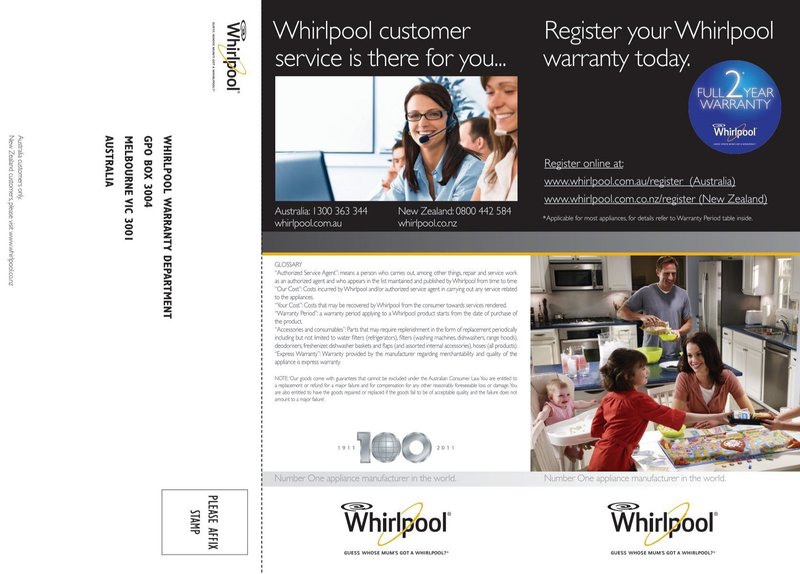
Navigating appliance warranties can feel like decoding a secret code. Whirlpool’s warranty is generous, but also surprisingly easy to void without realizing it. Let’s be real: nobody reads the fine print cover-to-cover. Still, a careless mistake (like using the wrong cleaner or skipping a step during installation) can leave you stuck paying for repairs. That warranty is your safety net—let’s make sure you don’t accidentally cut any holes in it.
Know Your Whirlpool Appliance Warranty
First things first: every Whirlpool kitchen appliance comes with its own warranty coverage, but there are some basics you can count on. Typically, you’ll get one year of full coverage for parts and labor on most kitchen models. But here’s the thing—many functional parts (like certain seals or the drive motor) might be covered for even longer, depending on the appliance.
The catch? The warranty only holds as long as you don’t break the rules. Whirlpool lays out clear do’s and don’ts, and they’re not just being picky. These rules ensure your kitchen gear is safe and works the way it should. Think of it like following the rules of a board game—bend them, and you’re out.
Most warranties don’t cover “user error.” So, if your refrigerator dies because you hardwired it wrong or tried a DIY code reset that went sideways, that’s on you. Knowing exactly what the warranty covers (and what will get you in hot water) is the first step toward protecting your investment.
Why Professional Installation Matters
I get it—you might be handy, or maybe you’re looking to save cash by installing your new Whirlpool dishwasher or oven yourself. But here’s the thing: Whirlpool’s warranty often hinges on *professional* installation. Doing it yourself can easily void coverage, even if everything seems to work perfectly for a while.
A licensed installer doesn’t just hook things up and call it a day. They’ll:
- Check water, gas, and electrical connections for safety
- Follow Whirlpool’s pairing and setup codes (these can change with new models)
- Test everything to ensure the appliance syncs correctly with your home systems
If anything’s not up to Whirlpool’s standards (wrong water hose, missing ground wire, skipped troubleshooting steps), you could lose out on repairs. Play it safe and keep your installation receipts—Whirlpool can ask for proof if you ever make a claim.
Tip: If you move or sell your appliance, include the original installation paperwork. It makes warranty transfers smoother and proves the job was done right.
Using Only Approved Replacement Parts
Say your Whirlpool fridge’s ice maker goes on strike, or the oven’s heating element fizzles out. It’s tempting to hop online and order a cheaper off-brand part. But here’s where things get risky: installing non-Whirlpool parts can instantly void your kitchen appliance warranty.
Whirlpool-approved parts are guaranteed to work properly, code with the appliance’s controls, and pair with its safety mechanisms. Generic or universal parts might seem “close enough,” but honestly, they can cause real trouble:
- Short circuits or electrical failures
- Improper sync with digital controls
- Loss of specialized features like self-cleaning or troubleshooting sensors
Stick to Whirlpool-branded or certified parts—even for things that seem simple, like fridge filters or oven lights. Always document the repairs: who installed the part, when, and what was used. Whirlpool may ask for this info if there’s ever a warranty question.
The Risks of Unauthorized Repairs and DIY Fixes
This is a big one. Maybe your dishwasher starts blinking a mystery code, or your range suddenly won’t reset. You might be tempted to tinker or look up a popular YouTube fix. But here’s the catch: unauthorized repairs, including “simple” ones like battery swaps in a control panel, can break your warranty.
When a non-certified tech (or you) opens up an appliance, it’s nearly impossible for Whirlpool to guarantee the work was done correctly. That means if anything else fails—even if it seems unrelated—they can refuse future claims. Plus, if a failed DIY repair causes more damage, you could be out even more cash.
Here’s the thing: Whirlpool-trained techs don’t just fix problems, they follow troubleshooting steps that keep your appliance in warranty. They know when to reset a remote or replace a part without messing with the sealed systems. If you see a strange error code, call authorized support first—even if it seems like a hassle.
Keeping Up with Proper Maintenance
Just like you need to give your car regular oil changes, Whirlpool expects you to maintain your kitchen appliances—and keep records of it. Skipping regular cleaning, not replacing water filters, or letting grime build up inside your dishwasher might sound harmless. But it’s actually one of the biggest ways people accidentally void their warranty.
For starters, some breakdowns are considered “preventable maintenance”—meaning the company assumes you’ll do regular check-ups. If they see mold in a fridge gasket, or a fried electronic board due to years of dust, they’ll say the problem was avoidable. No warranty coverage.
Keep a log of every time you do routine cleaning, battery replacements, or filter swaps. If you’re ever dealing with a warranty claim, showing you’ve followed Whirlpool’s maintenance recommendations can help your case. Plus, your appliances will just…last longer.
Registering Your Appliance and Saving Paperwork
It’s easy to forget, but registering your Whirlpool appliance is more important than you think. The process usually takes five minutes online or over the phone. Why bother? Because if your appliance has a warranty issue, proof of registration and original purchase can make or break your claim.
Here’s how it usually works:
- Register your appliance online using the model and serial number
- Upload or save your purchase receipt and installation documentation
- Whirlpool uses this info to verify coverage, model history, and troubleshooting support
Without registration, you might be scrambling to prove when your oven or dishwasher was bought, or if it’s even covered at all. If you ever need repairs or help pairing a remote or digital control, having everything documented lets Whirlpool help you faster.
Insight: Moving soon or planning to sell? Registered appliances with up-to-date paperwork can add value and give peace of mind to the next owner.
Don’t Ignore Those Small Print “Exclusions”
You might be surprised by how many things are quietly excluded from your Whirlpool warranty. For example: cosmetic damage, power surges, or problems caused by pests aren’t usually covered. If your control panel glitches after a lightning strike, or the remote stops syncing due to water damage, you’re likely out of luck.
Here are a few easy-to-miss “warranty killers”:
- Using commercial cleaning products not recommended for Whirlpool finishes
- Pairing digital appliances with non-certified remotes or smart home systems
- Moving the appliance yourself (drops, bumps, and rough handling are usually not covered)
Whenever you’re about to try something new—like pairing your fridge with a universal remote code or syncing it with a smart hub—stop and check Whirlpool’s approval list. Sometimes, what seems like a cool feature can put your warranty at risk.
When in Doubt, Ask Whirlpool Support
Honestly, the fastest way to keep your Whirlpool kitchen appliance warranty safe is to ask for help the moment you’re unsure. Whirlpool has customer support for a reason, and they’re happy to walk you through proper troubleshooting, reset instructions, or code issues for your specific model.
Let’s say you’re dealing with a cryptic blinking code on the oven, or your refrigerator remote needs a tricky battery swap. Rather than guessing (or searching for random “hacks”), call or email Whirlpool support. They’ll tell you exactly which steps are safe—and which ones to skip so you don’t void your warranty.
If you ever do need a repair, Whirlpool can help you find certified technicians who keep your warranty intact. This might cost a little more up front, but it’ll save you a headache—and potentially a big bill—down the line.
Bottom line: When in doubt, don’t risk it. One quick call can protect years of coverage on a pricey appliance.
It’s easy to overlook the fine print, but taking a few smart precautions will keep your Whirlpool kitchen appliances safe, covered, and running smoothly. Don’t be afraid to ask questions, keep your paperwork, and lean on the pros when you need to. That way, you’ll get the most out of your warranty—and your appliances will have your back for years to come.
